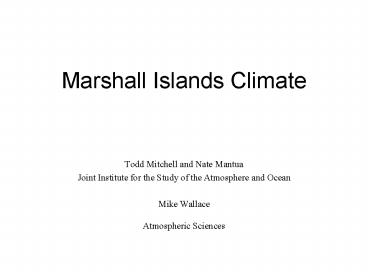Marshall Islands Climate - PowerPoint PPT Presentation
1 / 14
Title:
Marshall Islands Climate
Description:
Each gold line is the Majuro precipitation in the 3 years surrounding the ENSO warm episode. Same but for cold El Ni o / Southern Oscillation (ENSO) episodes. ... – PowerPoint PPT presentation
Number of Views:40
Avg rating:3.0/5.0
Title: Marshall Islands Climate
1
Marshall Islands Climate
- Todd Mitchell and Nate Mantua
- Joint Institute for the Study of the Atmosphere
and Ocean - Mike Wallace
- Atmospheric Sciences
2
- 29 coral atolls (19 inhabited) 5 coral
pinnacles (4 inhabited) - two roughly parallel chains Ratak (Sunrise)
and - Ralik (Sunset)
- 4-20N, 160-173E
- 180 sq km (70 sq mi.)
- Source (Ency. of the Nations)
3
NCEP precipitation reconstruction --- not the
NCEP NCAR reanalysis
4
- The NCEP precipitation reconstruction is
constructed in the following manner. - Empirical Orthogonal Function (EOF) Analysis is
used to characterize the spatial patterns of
anomalous satellite Outgoing Longwave Radiation
Precipitation Index (OPI) variability in 1979 to
present. The OPI does a better job of capturing
precipitation in regions where the precipitation
occurs in deep convective clouds. This is the
case in the western equatorial Pacific, but the
OPI is not a perfect estimate of precipitation.
The leading EOF most likely captures the regional
deficits and abundances in precipitation that are
associated with the El Niño / Southern
Oscillation. - The sign and amplitude of each EOF spatial
pattern in each year and month of data is
determined by calculating the degree to which the
distribution of island and land precipitation
anomalies in a given month are similar to each
EOF spatial pattern. This allows one to
calculate the amplitude and sign of each pattern
going back to 1948. - The major weaknesses of this method are the
errors in the OPI estimates, and that the EOF
calculation period of 1979 to present precludes
the data from representing fluctuations of
periods longer than 25 years. - More information at ftp//ftp.cpc.ncep.noaa.gov/pr
ecip/50yr/
5
912500 ENIWETOK 11.4n 162.4e 150cm 1947-1972
43/50-years 913660 KWAJALEIN 8.7n 167.7e
260cm 1946-2004 -9/50-years 913760 MAJURO
7.1n 171.4e 340cm 1954-2004
-16/50-years 913690 JALUIT 5.9n
169.6e 400cm 1896-1968
6
(No Transcript)
7
Tropical storms and hurricanes can contribute to
Marshall precipitation, but they are not a
regular occurrence.
8
(No Transcript)
9
Same figure with contours of annual total
precipitation added (1, 2, 3 meters).
10
The precipitation trend shown for the global
domain.
11
The Majuro precipitation climatology.
12
The red bar indicates the core months of above
normal sea surface temperature in the eastern
equatorial Pacific associated with the El Niño /
Southern Oscillation (ENSO). Majuro tends to
experience extreme drought in the January through
April at the end of the ENSO. Each gold line is
the Majuro precipitation in the 3 years
surrounding the ENSO warm episode.
13
Same but for cold El Niño / Southern Oscillation
(ENSO) episodes. Majuro doesnt seem to
experience a consistent pattern of precipitation
abundances or droughts during cold ENSO.
14
Mean Majuro dry season (January through April)
precipitation (y-axis) plotted as a function of
ENSO-related sea surface temperature anomalies
(x-axis). The digits plotted are the last two
digits of the year of the Majuro dry season, for
example, 83 is 1983. Majuro experienced lt 5cm
precipitation per month during 1983 and 1998.































